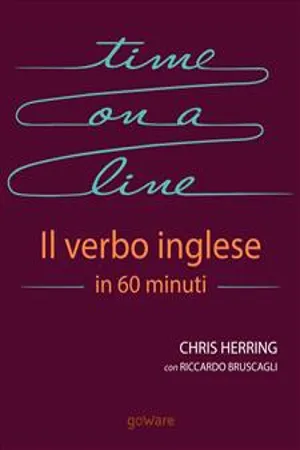
- English
- ePUB (mobile friendly)
- Available on iOS & Android
Time on a Line. Il verbo inglese in 60 minuti
About This Book
Time on a Line is a chart offering a visual guide of the main tenses used in spoken English. Having a visual is a fast way to understand where the tenses (called tempi in Italian) are in relation to time. This book is not a grammar book full of theories and long detailed explanations of the hows and whys of grammar. Nor is it a pretense to a complete in depth coverage of all the possible tenses used in the English language. I intentionally did not include such gems as future in the past, reported speech or even the passive. This book is a quick study of the most commonly used tenses necessary for "speaking". It is written for anyone who has ever studied English but can't quite put this knowledge into practice. Its aim is to help bridge the gap between knowing English grammar and using it either in speaking or understanding it. Time on a Line è una mappa che offre una guida – subito comprensibile visivamente – dei tempi usati in inglese. Osservare una mappa è una via veloce per capire quali tempi verbali usare in relazione alla dimensione tempo (in inglese si distingue opportunamente fra tense, il tempo verbale, e time, il tempo in generale). Questo libretto non è una grammatica teorica, né una lunga dettagliata esposizione del come e del perché di un determinato uso grammaticale. Non ha nemmeno la pretesa di coprire tutti i possibili tempi verbali usati in inglese. Intenzionalmente, non ho voluto includere preziosità come il future in the past, i tempi del discorso indiretto, e nemmeno la forma passiva del verbo. Questo libretto è invece un'illustrazione concisa dei tempi più comunemente usati in inglese e necessari per "parlare" la lingua. È scritto per chiunque abbia studiato un po' di inglese ma non è in grado di tradurre in pratica quello che già sa. Il suo scopo è quello di aiutare a colmare la distanza fra la conoscenza della grammatica inglese e l'uso della lingua, nel parlato e nella comprensione.
Frequently asked questions
Information
Exercises
• Present Simple exercises •
1. Fill in the blanks using the verb in the parenthesis | Completa le frasi con i verbi tra parentesi
2. Convert the above sentences into negative and interrogative sentences | Trasforma le frasi del precedente esercizio in frasi negative e interrogative
Do we go to work every morning?
Table of contents
- Cover
- Title page
- Credits
- Description
- The Authors
- Time on a Line
- How to use this book
- The infinitive
- Present Simple
- Present Continuous
- Imperative
- Past Simple
- Present Perfect
- Present Perfect Continuous
- Past Continuous
- Past Perfect
- Future Simple
- Future Continuous with time clause
- Future Continuous w/going to
- Modal verbs
- Conditionals
- The amazing g-verb TO GET
- Contrast and compare
- Appendix
- Exercises